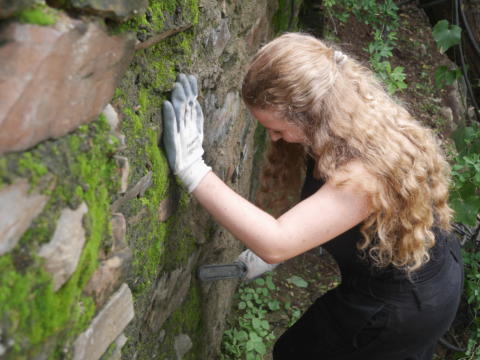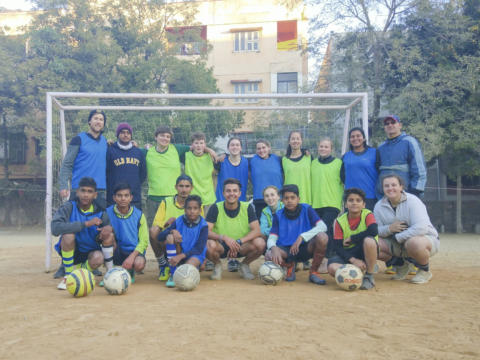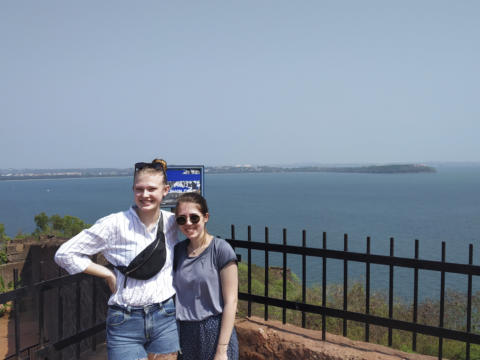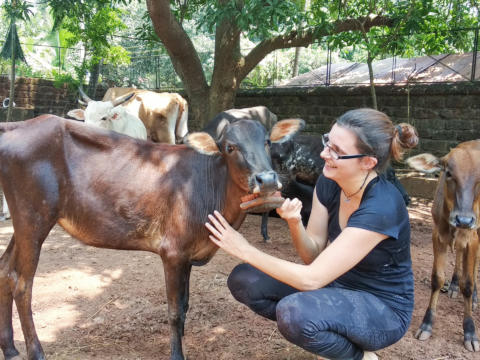Only 420€ per week!
Construction and Renovation
Rajasthan - India
Get your hands dirty and help the underprivileged communities and their schools in India with construction projects!
The main construction site of this project is located in a local hearing-impaired school allocated to the poor, but can also take place elsewhere in the area where development construction assistance is needed. While assisting the local community with their developments, you will gain valuable experiences as well as cultural exchanges with the Indian people.
Program Description
On this project, you will get your hands dirty with construction projects. Our main focus when constructing is working at the hearing impaired school allocated to the poor. This project takes place in the city of Udaipur where we are located at. Despite the previous efforts, the work here is far from done and we continue to renovate pathways, toilets, walls, etc. Moreover, those with artistic talents can help decorate the walls by creating images and sketches of their home countries and cultures. We have the feeling that this will be a nice way of reflecting the hard and good work that has been done by our participants over the past years.
Other construction efforts might be carried out in the local village (renovating and building houses and sanitation facilities) or working on construction projects at the local hospitals – this very much depends on the needs of any particular time and so our participants will be using their construction skills where they are most needed!
Aims & Objectives
This project aims to improve the quality of life for underprivileged citizens in and around Udaipur.
Schedule
Monday
On your first day of the program, you will have an orientation, to better understand your new environment and program. Our coordinators will take you to an energized authentic Rajasthani cultural dance concert, visit the local market, and a few supermarkets located close to our center. You can also utilize this time of the day to exchange your currency or purchase any of the essential items you might need during your stay.
Tuesday
On the second day (Tuesday) of your first week, introduction to the local projects and program will be given through an observation time at the project site. Our coordinators will also theoretically orient and train you on the project activities onsite so as to introduce you to the project in a step-by-step manner.
Wednesday to Friday
Your time on the project will commence on Wednesday.
You will begin with a meeting with the coordinator, discussing what is required during your stay at the project. There is a focus on light construction work and you will be expected to help paint the school buildings, make tables and chairs, construct and renovate the playground, make pathways, build toilets, repair the school wall and help build the new classrooms. Construction and renovation work is available in more places when required in the local area.
Note: This schedule can be changed and/or amended depending on weather conditions, local conditions and unforeseen circumstances.
Participant Criteria & Requirements
Standard Requirements
Minimum age: –
Maximum age: –
Minimum English level: Basic
CRB required: On Signup
Passport copy required: On Signup
Resume copy required: No
Required qualification: None
Additional Requirements
- Due to the active nature of this program, a decent level of fitness is required.
- Participants below the age of 18 should have parental consent.
- Participants above the age of 65 should have medical clearance.
Additional Equipment
There is no specific additional equipment.
Location
The Royal city of Udaipur located in the state of Rajasthan is commonly called the Venice of the East and nicknamed ‘the city of lakes’ is located in the princely state of Rajasthan. Primarily known for its art and architecture, it has temples dating as far back as 950 AD and palaces dating back to the Rajput era. Fans of The Jungle Book and James Bond films may recognize Udaipur as the birthplace of Bagheera and the location for the Roger Moore starrer Octopussy. Drawing several million tourists a year, it has loads to offer in terms of art, architecture, culture and cuisine. With all of this and more, Udaipur is one of the cities everyone should visit at least once in their lives.
About the Accommodation
There is a mini library where you can read, a beautiful garden with a lawn to relax in and dining and living room areas where you can hang out with fellow participants.
Food Arrangements
The meals are a mix of Western and Indian food, consisting mainly of vegetarian dishes including rice and vegetables. You can expect to have a chicken dish about twice per week. You can also use the kitchen facilities to cook for yourself or eat out at any of the local restaurants.
Facilities
Our house is located Seven kilometers away from the city center, where you can find anything you might need.
The nearest ATM and supermarket are located 2 Km from our accommodation, we can help you get there and return.
Activities & Events
No scheduled activities outside the program.
Sights & Surroundings
Jaisalmer, a gigantic sandcastle that remains inhabited and has mesmerized people from all over the world. With ninety-nine bastions, the castle encircles shops, a palace and more.
Pushkar, a Hindu pilgrimage town that is set around a holy late and home to one of the few Brahma temples, over fifty bathing ghats and over 400 temples. The main street is a long bazaar, where you can find any souvenir you can think of to bring back home.
Jodhpur, dubbed “The Blue City” for its blue-tinted edifices, Jodhpur is considered an architectural masterpiece due to its ever-photogenic streets and Mehrangarh, a magnificent fort that towers over the town.
Jaipur, a colorful and flamboyant city made famous by the Hawa Mahal, a pink-toned building that towers over the main bazaar and was historically built for royal women to be able to see festivals without being on the streets.
Ajmer, famous for its Islamic heritage and for containing one of India’s most important Muslim pilgrimage centers. In Ajmer, you’ll be able to find examples of Muslim architecture such as the Jain golden temples.
Transportation
From this location we do not provide free transport to other locations.
Quick Facts
Name: Republic of India (Bhārat Gaṇarājya)
Population: 1.252 billion
Capital: New Delhi
Language: Hindi, English and 22 other officially recognized languages
Currency: Indian Rupee (INR)
Time zone: UTC +5:30
Country Information
India is known for its pyramid-like temples, its colorful streets and it’s crowded cities. This country represents one of the most vivid and the largest cultures in the world. From the golden triangle of Delhi, Jaipur and Agra to the coast where Ayurveda medicine was born, India offers a 360 degree journey through the most magical of lands. Known for being the second most populated country in the world, India will show you the faces of thousands of Hindu gods in its very vast collection of temples all throughout the country. The land of colors and smiles is ready to take you on your next adventure whether road tripping or helping out in local communities, this sub-continent will amaze your senses. India will shift the way you see the world.
India’s literacy rate is around 60% for women and 80% for men. The principal language is Hindi and English is also commonly used in all major cities. New Delhi, the capital of India, is what many would call the real deal when travelling through the country. It is one of the biggest and most populated cities in the whole world with up to 25 million citizens. New Delhi is known for its amazing cuisine and its new modality of “street food”, which means restaurants with every specialty you can imagine are available to you all throughout the city! Chennai is another of the biggest cities in India, known as the “Detroit of India” for its automobile industry. If you are looking for a quieter spot Kerala is the centre of lifestyle, art, architecture, language and literature in all of the country!
Climate
India is so vast that climatic conditions in the far north have little relation to those of the extreme south. While the heat is building up to breaking point on the plains, the people of Ladakh, in the Himalaya, will still be waiting for the snow to melt on the high passes.
India has a three-season year – the hot, the wet and the cool. Generally, the best time to visit is during winter (November to February) although there are regional variations.
Summer (hot): The heat starts to build up on the northern plains of India from around February, and by April or May it really heats up. In central India temperatures of 45 °C and above are commonplace. Later in May, the first signs of the monsoon are visible in some areas – high humidity, violent electrical storms, short rain-storms and dust storms that turn day into night. The hot season is the time to leave the plains and retreat to the hills, and this is when Himalayan hill stations are at their best (and busiest). By early June, the snow on the passes into Ladakh melts and the roads reopen.
Monsoon (wet): When the monsoon finally arrives, it does not just suddenly appear. After some advance warning, the rain comes in steadily, generally starting around 1 June in the extreme south and sweeping north to cover the whole country by early July. The monsoon doesn’t really cool things down: at first hot dry and dusty weather is simply replaced by hot, humid, muddy conditions. Even so, it’s a welcome relief, not least for farmers who face their busiest time of year as they prepare fields for planting. It doesn’t rain solidly all day during the monsoon, but certainly rains virtually every day and the water tends to come down in buckets for a while followed by the sun. The main monsoon comes from the southwest, but the southeast coast is affected by the short and surprisingly wet northeast monsoon, which brings rain from mid-October to the end of December.
Winter (cool): Finally, around October, the monsoon ends for most of the country, and this is when most tourists visit. Generally, it’s not too hot and not too cool (although in October it can still be surprisingly humid in some regions). Delhi and other northern cities become quite cold at night in December and January. It certainly becomes cold in the far north. In the far south, where it never gets truly cool, the temperatures become comfortably warm.
Culture
Hinduism is a big part of the story and construction of Indian culture. India is known for its distinctive arts such as architecture, literature and performing arts but in the modern era it has shifted towards the film industry. Bollywood is followed by the Middle East, South Asia and even Russia! Their movies are known for its musical intake and beautiful stories and characters, all, native Indian. One of the things that characterize India the most is its caste system; this model includes the old tradition of arranged marriages and very traditional family values throughout castes and the country. Don’t miss a cricket match when you visit! It is the nation’s favourite sport and a beloved pastime in the country.
Hinduism, Islam, Christianity, Sikhism, Buddhism, Jainism and Zoroastrianism are the major religious communities in the country. According to the 1990 census, Hindus constitute about 83% of the population followed by Muslims with 11% and Christians with 2%. Sikhs constitute about 1.6 %. Buddhists 0.6% Jains 0.3% and Zoroastrians (Parsees) 0.085%, of the 1 billion population. The rest constitute other minor religions. The population of all the 6 major religions has increased but Jainism has increased only marginally. India is a land of bewildering diversity. It is a jigsaw puzzle of people of every faith and religion, living together creating a unique and colorful mosaic. There is a festival for every reason and season. Many festivals celebrate the various harvests, signifying great historical figures and events while much express devotion to the deities of different religions. Every celebration revolves around rituals of prayer, seeking blessings, exchanging goodwill, and decorating houses, wearing new clothes, music, dance and feasts.
Transportation
The Indian railways are one of the largest undertakings in the world. The network covers a distance of over 60,000 Km. Road covers 5.5 million kilometers and over 10,000 km of inland navigable waterways. Using rail and bus services, one can reach almost any point on the Indian map though not always on time. All large cities are also connected with domestic air services.
Buses operate frequently to all smaller towns to/from major cities. There are also inter-state buses that take you from one city to the other (non stop). Before booking your bus tickets, always check the time it would take from one point to the other. For the local buses, you buy the ticket once you get on. For the lines that go between cities you will have to book and pay in advance.





